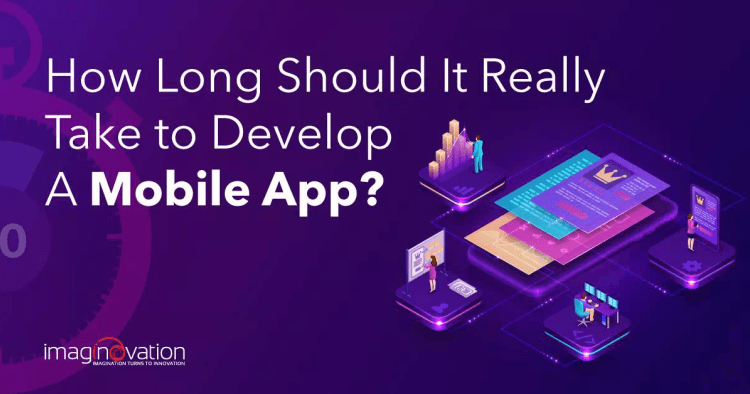With mobile app development, one of the most frequently asked questions is—how long does it take to develop an app? Mobile app development is a complex process with myriad factors that contribute to the complete app development lifecycle.
It’s like building your dream home. The more specific your requirements, the more time, effort, and money will be required. Therefore, it’s a bit challenging for app developers to provide a straightforward answer to this query. However, just as constructing your dream home is unique, we want you to make the most of today’s mobile revolution and enjoy the app development process.
In this blog, we will demystify the mobile app development timeline and explore how long it takes to create an iOS and Android app.
Let’s dive in!
Key Facts on the Booming App Economy
The app economy is booming. Before we delve into the app development timeline, let’s explore why entrepreneurs worldwide are investing in mobile app development.
Fact #1: Mobile App Market is Set to Grow Steadily
According to reports, the mobile app market will steadily increase. Statistics highlight that consumers downloaded 204 billion mobile apps in 2019, up from 140.7 billion app downloads in 2016.
Experts forecast this number to grow to 258 billion in 2024, a 45% increase over five years.
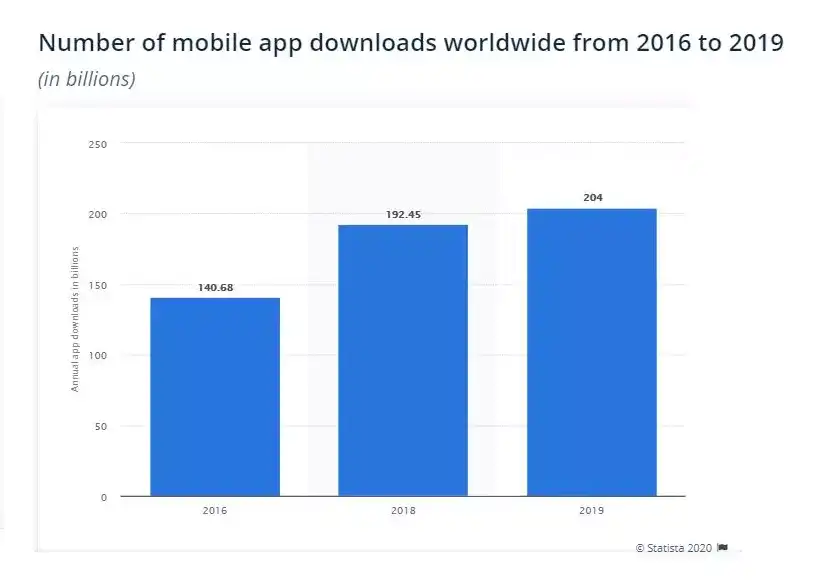
Image 1: Number of Mobile App Downloads Worldwide from 2016 to 2019 | Source
Fact #2: Google Play and Apple’s App Store Continue to be Big Players
Let’s look at how Android and iOS apps have performed so far. Android users could choose between 2.56 million apps in the first quarter of 2020, making Google Play the app store with the most significant number of available apps. Apple’s App Store was the second-largest app store, with around 1.85 million available apps for iOS.
Fact #3: Total Revenue from Mobile App Downloads Set to Increase
In the context of revenue, in 2016, the total revenue from mobile app downloads, advertising, and in-app purchases was $88 billion. Experts forecast this number to cross over $188 billion in 2020, a 113% increase over four years.
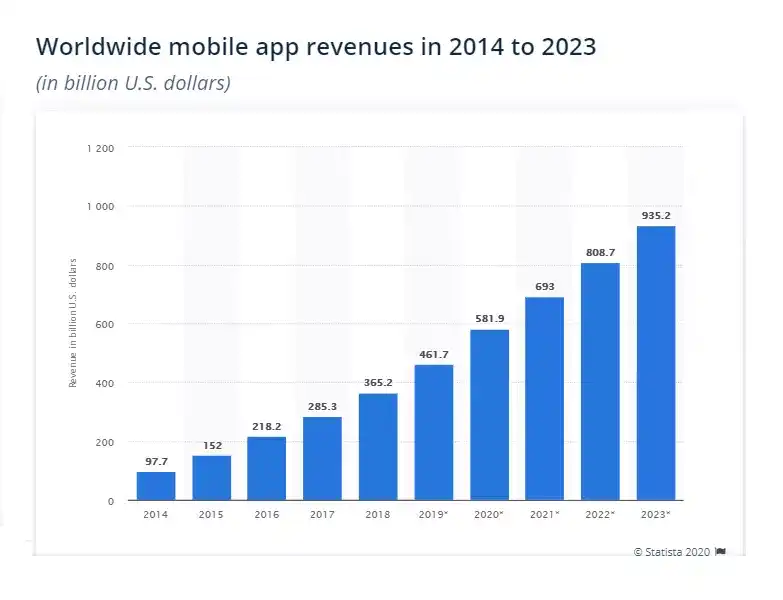
Image 2: Worldwide Mobile App Revenues in 2014 to 2024 | Source
The app development story looks promising. As a business owner, understanding the app development stages is crucial. By familiarizing yourself with the various phases and the app development timeline, you can bring in excellent value at reduced costs and time.
Also Read: Android vs iPhone Users: What You Need to Know Before Developing A Mobile App?
How Long Does it Take to Develop an App? The Estimated Timeline
A lot gets into the app development basket—project intricacies, timeline glitches, last-minute add-ons, and more. So, there is no black and white answer to how long should it take to develop your app. You will find some apps getting completed in 3 months, whereas some taking as much as 8 to 12 weeks.
The app development timeline gets affected by various factors, such as the type of app or experience of a development company.
Let’s look at each phase in the app development process to understand what it includes and how much time it could take.
Stage 1: Research and Ideation
[Time: Several weeks]
You can create a brilliant vision when you base your app on thorough research. You must research your competitors, target audience, the technology you’d want to use, and more.
Let’s take an example: For Facebook-like social media apps, the target audience is a mixed group of all ages. Whereas, for Tinder (or any other dating app), the ideal target audience is younger people.
When you get into ideation, you’d want to keep your target audience at the heart of development.
(Check out best strategies for mobile app market research.)
It would be wise to conduct extensive research on market demand and customer needs. The insights will help you with:
- Identifying and substantiating a monetizable customer problem
- Estimating your market size
- Validating your product idea
Holistic research will give you insights into competitors, potential threats, and other challenges. You can work around such problems and come up with excellent app strategies to cater to your defined target audience.
Stage 2: Mobile App Planning aka the ‘Discovery Phase’
[Time: 2-4 weeks]
With crucial insights based on research, the development company of your choice can generate a detailed brief about your mobile app idea. It helps them understand your potential customers better, plan the app project requirements, and define your business goals.
Typically, the steps should include:
- How do you want to develop the app?
- What features will be included in the app?
- How will the user experience flow? (Project wireframes will need to be created)
- The preferred choice of platform (iOS, Android, or both)
- The preferred communication protocol and security preferences
It is critical to get this planning stage right, as it has ripple effects on all other stages. For a seamless mobile app development experience, you can also reach out to an experienced development partner, such as Imaginovation, who can guide you directly.
Typically, at the end of this discovery stage, you would know whether you’d opt for a Minimum Viable Product (MVP) or a more extensive app. You will fully understand what exactly needs to be designed and developed, with detailed project requirements, a timeframe, and cost that will be generated by the development company.
Stage 3: Design
[Time: 1-3 months]
In this phase, designers put their creative hats on and start bringing the app to life. Well, almost! The timeline for designing a mobile app varies and is typically based on app complexity.
What do designers work on in this phase? They work on:
- Designing the interface or UI, the look-and-feel of the app
- Creating flow control and structures
- Making raw designs, using tools like Sketch or Adobe XD
- Completing wireframes, mockups, and prototypes
Designers work on building every facet of the app, from icons, logos, backgrounds, and more. Another crucial aspect that designers will be involved with is collaborating with developers.
It’s important to check with the developers on the practicality of developing a specific design. The more cohesive your team collaboration, the more time you save with redesigns. And, the end result of this collaboration is a brilliant app.
Stage 4: Development
[Time: 12 months or more]
The development phase is typically time-consuming. Developers work towards flawless and error-free coding. Many developers nowadays prefer working on an agile methodology that facilitates early and predictable delivery of the app.
It is also common for developers to divide the parts of the project according to their area of expertise and start working simultaneously. They usually work on Sprints or Milestones.
When it comes to development, you’ll often hear about Backend development and Frontend development.
Backend Development
At this stage, developers need to plan out facets such as:
- Data storage: Storing files that are meant for the app, through internal storage, external storage, or shared storage
- Server-side logic: Mapping user requests from a UI and flows implemented by the application server
- User Management: Handling user authentication and password management
- Data Integration: Setting processes to extract and distribute data across multiple data locations
- Push Notification: Sending notifications to the user’s device from the server
- Versioning: Working on a new version without disrupting the existing one
Backend development can take around an estimated ten weeks. Typically, developers start frontend development before backend development, reducing the overall timeline for the mobile app development process.
Frontend Development
Frontend developers work on enabling functionality, usually taking around 5 to 10 weeks. Frontend development offers a real prototype, allowing for prompt user feedback.
Programmers typically utilize frameworks like Objective-C, Swift, and Java to create separate versions for the App Store and Google Play. At this stage, developers work on caching for temporary data storage.
This caching helps store the application’s data to reduce the app’s loading time, minimizing the requirement of calling the server.
Stage 5: Testing
[Time: 3-5 weeks]
Once development is complete, the testing phase begins. It is one of the most critical elements to ensure your app performs well. Testers/Quality Analysts work to find bugs and glitches that could jeopardize your app.
Typically, quality analysts work on various checkpoints and parameters to ensure that your app is holistically functional. Let’s take a quick look at some factors.
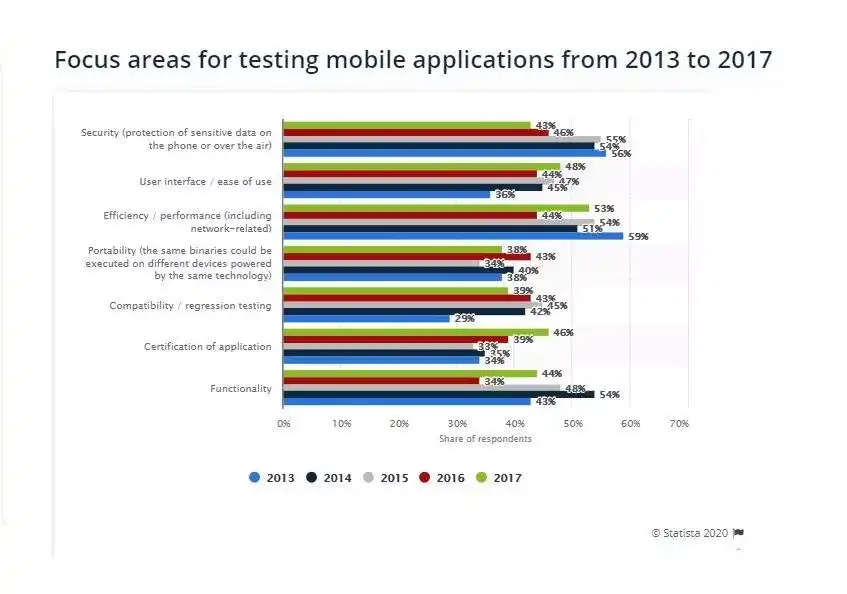
Image 3: Focus Areas for Testing Mobile Applications from 2013 to 2017 | Source
Although the statistic isn’t one of the latest snapshots on focus areas, it highlights some areas for testing mobile applications, including security, user interface (UI/UX), efficiency, portability, compatibility, certification of the application, and functionality, among many other checkpoints.
After the initial testing (aka Alpha testing), the app moves on to the next levels of testing, including beta testing, until it finally hits the virtual market shelves without any flaws.
Stage 6: Deployment
[Time: Apple App Store: 24 hours – 48 hours | Google Play Store: 2 hours – 72 hours]
Picture this—your app is tested and ready to go live. Great! What’s next? You need to follow specific steps to present your app to users in the app stores.
App stores, such as Apple and Google, have guidelines you need to follow to get onboard. The Apple App Store usually has stricter guidelines than its counterpart. The next question—how long will it take for your app to get on the app stores? Both stores review your app based on their review policies.
Apple App Store: Apple has stricter submission policies and wouldn’t allow low-quality or unsecured apps. If your app gets rejected, you’d need to communicate with Apple’s Resolution Center. Apps usually take around two days or a little longer for approval. App-owners often receive review feedback for 50% of mobile apps in 24 hours and over 90% in 48 hours.
Google Play Store: Google has some stringent quality guidelines that you’d need to follow strictly. It is wise to read every policy Google wants you to follow. For a first-timer, it would take a minimum of 3 days to submit your app and go live. However, if you are updating your app in the Play Store, it will be updated on the same day (within 2 hours).
Stage 7: Maintenance and Support
If you want to provide a great user and client experience, this stage will play a critical role. In this stage, you will take care of updates and upgrades, backups, server monitoring, troubleshooting, and continuous bug fixing.
The various stages give a more precise estimate of the timeline for developing a mobile app. Now, let’s have a quick look at the different amounts of time different mobile applications could take to be developed.
Table 1: Time to Develop Different Mobile Apps
| \\\\\\*\\\\\\*Type\\\\\\*\\\\\\* | \\\\\\*\\\\\\*Features\\\\\\*\\\\\\* | \\\\\\*\\\\\\*Time to Develop\\\\\\*\\\\\\* |
| Basic stand-alone mobile app | No Internet backend support | 3-4 months |
| App with server support | Backend support with service, mobile integration | 4-6 months |
| Intensive enterprise app | Niche design, extensive backend, and security | 6-12 months |
Next, let’s check out some common app examples and draw out insights.
Table 2: Time to Develop Mobile Apps Based on Functionality
| \\\\\\*\\\\\\*Type\\\\\\*\\\\\\* | \\\\\\*\\\\\\*Example\\\\\\*\\\\\\* | \\\\\\*\\\\\\*Time to Develop\\\\\\*\\\\\\* |
| Feature-rich, highly complex apps | Instagram and Uber | 6-12 months |
| Medium complexity compelling apps | WhatsApp and QuizUp | 4-7 months |
| User-friendly apps with lesser functionality | Tinder and Periscope | 3-5 months |
Did we mention that you may need to take into account some extra development time? That’s right! Sometimes, you will need to incorporate design improvements, etc., which would take up more development time
Scenarios that Require Additional Development Time
Design Improvements: This facet could take around several weeks for design creation, feedback, and approval on the user interface and user experience side.
Additional Integration: You can keep around 2 to 4 weeks extra time for integration.
Multi-platform: Multi-platform apps take a longer time to develop. How long does it take to make an iOS app? iOS apps require lesser development time than android app development. So, how long does it take to make an android app? The android app typically requires around 20-30% longer with development than its counterpart.
However, this is really a case by case scenario depending on the frameworks and technologies in which the development team uses, sometimes it can take longer to develop an android app rather than an iOS app, or it can take the same length of time. So, it can really depend on many different factors.
As app-owners, you must know the time to build a mobile app. You may want to speed up on the delivery front and be the first to market your app. However, you’d not want to compromise on the quality front. Here are some 2024 best practices for you.
2024 Best Practices to Expedite Mobile App Development
Ok, so is there any way to speed up the development of your mobile app?
Well, there are some best practices that can help you expedite the app development process. Let’s take a look.
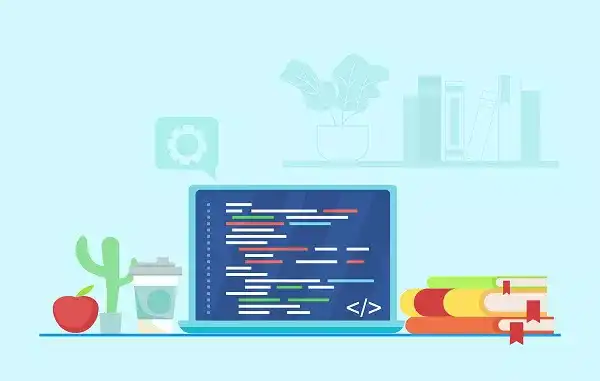
1. Launch MVPs or Prototypes
Minimum Viable Products (MVPs) or prototypes are a brilliant way to save time. So instead of a fully-formed product, you may opt to launch an MVP. The prototype can resemble your original idea of the app.
At this stage, you can continue to add features and make improvements. You may always implement this before the major launch, as you will get critical insights on how users will reach. Businesses such as MailChimp, DropBox, Airbnb, and many others started as MVPs.
Eric Ries, the co-founder of IMVU, describes in his book ‘The Lean Startup‘ how Dropbox validated their idea by creating an MVP along with a creative explainer video.
2. Try Cross-Platform
It can get overwhelming to choose between Android and iOS. Wait, here’s a quick tip for you. When developing individually, the timeline and cost of app development of both platforms can be relatively high.
You may opt for cross-platform app development. You have tools such as Xamarin and PhoneGap, which allow you to build brilliant multi-platform apps in less time.
3. Hire a Professional Development Company
A professional app development company can facilitate the development process more effectively, which will save more time and effort. You may get better insights, and you don’t need to feel overwhelmed or confused about procedures that you are not sure of.
Imaginovation is an experienced app development company that has developed a plethora of apps for a diverse clientele.
4. White Label Solutions
Imagine a company produces a product, and then someone rebrands it to like theirs. It’s a solution that quite a few businesses adopt. Such white label solutions can save a lot of time as you don’t need to build something from scratch.
However, it could be at the cost of lesser traffic or sales. Also, white labeling doesn’t guarantee you get all the required features in your app. That’s why it’s always best to get the custom app developed based on your requirements.
With the 2024 best practices, you will be able to reduce the app development timeframe. As a business owner, we understand your quest to develop a brilliant app that can facilitate your customers. Get started! It is always a good practice to learn from other apps, so look at some of the success stories and failure stories.
The insights will help you to know some of the pain points and challenges. You can develop a critical eye on the app development process and control the various stages and timeline to build your app more meticulously. The result—a brilliant app, of course!
Did we forget to mention? You will be able to develop apps that are intuitive and immediately usable. Best apps typically evolve. So learn from user experiences, and get ready to iterate and offer engaging app experiences.
Turn Your App Ideas into A Digital Reality with Imaginovation
Are you looking to create a mobile app while saving time and costs? If you’re unsure where to start, get in touch with us. At Imaginovation, we have helped a range of clients—from startups to Fortune 500 companies—by providing the best app development solutions.
We’ve designed a comprehensive discovery process, where we conduct in-depth research on your app idea and turn it into a digital reality.
Ready to build an app, but not sure where to start?
We've got you covered. Click the button below to get started.

